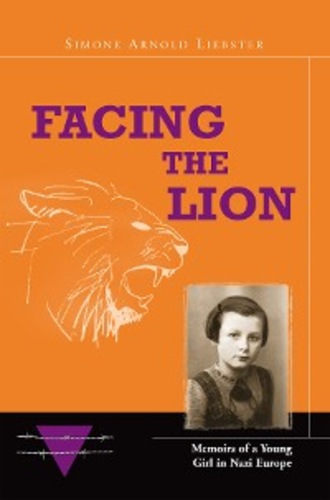
Полная версия
Facing the Lion

FACING
THE
LION
Memoirs of a Young Girl in Nazi Europe
Simone Arnold Liebster

Facing the Lion: Memoirs of a Young Girl in Nazi Europe
Copyright © Grammaton Press, U.S.A.
Distribution for Europe:
Editions Schortgen • BP 367 • L-4004 Esch-sur-Alzette • Luxembourg
Tel.: +352 54 64 87 • editions@schortgen.lu www.editions-schortgen.lu E-Book-Erstellung: Satzweiss.com Print Web Software GmbH
ISBN: 978-2-87953-139-7
DEDICATION
I dedicate this book to my beloved father who surrounded us with so much loving attention and beauty, and who provided gentle authority, exemplary courage, and a sense of humor, making our home a haven of peace.
I dedicate it to my cherished Mum who led her “little one” and helped her to grow into a happy adult, comforting her and surrounding her with motherly love and patience.
And also to Adolphe Koehl, Dad’s intimate friend, who so generously helped us to face our situation and whose exceptional courage and practical wisdom has enlightened my path.
And to my devoted aunt Eugenie who sacrificed all of her earnings and risked her life for us. She endeared herself to me like a second mother.
I shall not forget to dedicate this book to Marcel Sutter, whose life became an example for me and sustained me. He was a brother to me, a close friend.
I must include Charles Eicher, who encouraged me to go to New York. He put me in contact with my “Liebster,” and got me started in a new full and fruitful life.
HISTORICAL NOTE (von Abraham J. Peck)
HISTORICAL NOTE
During the period of National Socialism, the religious beliefs, teachings and actions of the Jehovah’s Witnesses were a public proclamation that approximated a way of life whose central tenets collided with those of the National Socialist state. Here was a small group of some 20 to 25,000 “average Germans” and those from other regions incorporated into the Third Reich who were publicly proclaiming their belief in a kind of shadow state, which was in direct opposition to the Nazi regime. Here was a group, which rejected the racial laws of the state, the oath of allegiance to Adolf Hitler, the German salute, and the duty to take up arms for Germany.
We are familiar with the statistics: nearly 10,000 Jehovah’s Witnesses imprisoned and at least 2,000 admitted to Nazi concentration camps of which at least half were murdered, over 250 by beheading.
What we do not know as well is the day-to-day existence of this extraordinary group of committed men, women and children under the rule of National Socialist terror.
That is why Simone Arnold Liebster’s autobiography is of such importance. It brings a name and a voice to these statistics. It tells the story of spiritual resistance to a monstrous evil, and does so through the eyes and memories of a child.
Those who resisted the forces of Nazi evil when a simple declaration of state loyalty would insure their well being, when a simple signature would free them from the hell of a labor or concentration camp and protect them from violence and murder have earned a special place and a special admiration. They give us hope and a belief in the ultimate triumph of human good.
Simone Arnold Liebster must be counted among these special people.
— Abraham J. Peck
Vice President of the Association of
Holocaust Organizations FOREWORD
FOREWORD (von Sybil Milton)
FOREWORD
The autobiography of Simone Liebster, née Arnold, is a compelling story about her personal search for faith and identity that entailed difficult social, political, and religious choices in her childhood. Born in 1930 near Mulhouse in Alsace, then part of France, Simone Arnold Liebster grew up in an extended close-knit Catholic family during the 1930s—a decade of political and social unrest and uncertainty. Religious conformity was the norm in this overwhelmingly Catholic region. In 1938, Emma Arnold, Simone’s mother, converted to the beliefs of Jehovah’s Witnesses, despite family opposition. Subsequently, Simone’s father, Adolphe Arnold, was also baptized as a Witness, and Simone converted while still a child, in 1941.
The areas of Alsace and Lorraine had been German between 1871 and 1918, reverting to French jurisdiction until mid-June 1940, when the region was again incorporated into the German Reich. Almost immediately, the Germans imposed their social and political values, rapidly excluding large numbers of so-called “undesirables,” including Jehovah’s Witnesses, who had no place in the German “new order.” German again became the language of the region; soon nonconformists had to fear denunciations by neighbors as the bonds of civil society were undermined.
Simone’s father, Adolphe, was arrested on September 4, 1941, less than one month after Simone had been baptized as a Witness. With his arrest, Simone and her mother faced mounting economic hardships since her father’s wages had been confiscated at his arrest, his bank account impounded, and her mother denied a work permit. During the following two years, Simone and her mother secured food in exchange for small jobs.
After his arrest, Simone’s father was initially imprisoned at the Schirmeck-Vorbruck internment camp in Labroque. This prison camp had been opened in mid-July 1940 “for individuals, whose behavior would damage German authority in the region” and “to teach disobedient elements in Alsace proper attitudes to work and the political order of the German Reich.”[1] The list of so-called “undesirables” and “disobedient elements” followed the usual categories applied by the Germans in all occupied territories and also included Jehovah’s Witnesses. Since their beliefs did not allow them to render unconditional obedience to any state, the Witnesses in Alsace and Lorraine were subjected to the same persecution that other Witnesses had been facing in Nazi Germany after 1933. Simone’s father, Adolphe Arnold, was subsequently moved from Schirmeck to Dachau and Mauthausen-Gusen concentration camps, and later liberated in May 1945 at the Ebensee subcamp of Mauthausen.
After 1941, Simone came under increasing physical and psychological intimidation at school to conform to her classmates’ behavior, since she had refused to use the “Heil Hitler” salute or to join the League of German Girls (Bund deutscher Mädel). Intimidation and retaliation extended to school-age Jehovah’s Witness children both in Nazi Germany and in incorporated Alsace and Lorraine. When Witness children refused to enroll either in the Hitler Youth or the League of German Girls or to conform to the norms of Nazi social and political behavior, school officials removed them from parental custody and sent them to Nazi homes and juvenile correctional institutions.
More than 500 such minor Jehovah’s Witness children in Nazi Germany were involuntarily separated from their parents after formal judicial proceedings. Simone’s autobiography gives us explicit details about the lives of these children in a Nazi reform school during the war years. Parental custody and contact was suspended if a child was found guilty of immoral and dishonorable behavior—that is, not belonging to Nazi organizations. School officials, police, and juvenile and district courts ruled that Witness parents endangered their children’s welfare by not conforming to the norms of a Nazified educational system and society. The subsequent fate of these children removed from their families has seldom been told in detail. Simone Arnold Liebster’s memoirs enable us to understand more about the experiences of these children.
Simone Arnold was expelled from school after being subjected to physical and psychological brutality and pressures to conform. At the age of twelve, she was taken from her mother’s custody and involuntarily transferred to the Wessenberg Erziehungsanstalt, a reform school, in Konstanz (Germany). Plunged into a world of persecution and lacking contact with her parents, Simone Arnold had to surrender her adolescence in order to survive. The world of childhood and adolescence is usually a time of growth and development. For children trapped under Nazi rule, life became an inverted world of shrinking horizons and terror.
Simone Arnold Liebster’s autobiography restores individuality and identity to the otherwise anonymous victims of the Nazis and reveals her strength of will to maintain whatever normality was possible in her fight for physical and psychological survival. Her story is one of hope, strength, and courage. Despite the harsh and tragic Nazi period, Simone Liebster’s narrative reveals her courage in maintaining her social and religious values. It is a story worth reading and enables us to understand the fate of Jehovah’s Witness children during the Holocaust.
— Sybil Milton, former Senior Historian, U.S. Holocaust Memorial Museum Spring 2000
ACKNOWLEDGMENTS
ACKNOWLEDGMENTS
I have told this story as accurately as I can remember it, but I am grateful to many people who helped me put my account in its present form. Among them are Germaine Villard, Francoise Milde, Adolphe Sperry and his granddaughter Virginie, and Esther Martinez, who all did historical research to confirm the events and places I remembered. I also compared notes with Rose Gassmann and Maria Koehl, who have vivid eyewitness recollections of their own. Mrs. Bautenbacher at the Wessenberg’sche Erziehungsanstalt fur Mädels and the staff at the city archives of Constance assisted in obtaining documents relating to my incarceration. Author Andreas Müller, who has written about my husband’s story, also shared interesting background information with me about the activities of the Hitler Youth. Additional documentation and photographic material were supplied by the archives of the Watch Tower Society in Selters, Germany, Thun, Switzerland, and Brooklyn, New York. The Cercle Européen des Témoins de Jéhovah Anciens Déportés et Internés, of which I am a foundation member, also contributed archival material.
Claudia Walter, Daniel and Nadège Foucher, and Elaine Siegel did the important and tedious work of processing my manuscript. Werner and Michelle Ebstein and Norman Gaydon translated letters and documents for me. Suzanne Glesser applied her considerable creative talent in designing the artwork for the cover. Rick and Carolynn Crandall and their colleagues patiently edited and drew together the various pieces into a coherent work.
Two persons have meant a great deal to me: Fred Siegel, my publisher, whose positive attitude and backing have brought the project to reality, and Eunice Timm, whose meticulous proofreading was indispensable.
The urging of two wonderful friends, the late W. Lloyd Barry and John E. Barr, gave me the needed motivation to write my story.
I must acknowledge a very special debt to Jolene Chu who gave me an enormous amount of help—for illuminating discussions, for her careful review of the manuscript, for her efficient writing skills, and for her cheerfulness, which was a source of encouragement for me. This work has brought us together and has built strong ties between us. I have found in her a daughter who could chronicle my story as if it were her own heritage.
Finally, I owe special thanks to my dear husband Max for his exceptionally patient and loving support.
INTRODUCTION
INTRODUCTION
All over Europe people were getting ready. The fiftieth anniversary of liberation from Nazi terror was designated as a period of remembrance. The world would once again focus on the period often referred to as “the pit,” “hell,” “the age of terror,” or “the night.” The little group of survivors, eyewitnesses who had borne the purple triangle (the concentration camp uniform symbol for the Jehovah’s Witnesses) also had their own commemorations in Strasbourg and in Paris. They traveled to many French towns with an exhibition and told their story. And then came the flood of questions—questions about facts, but also inquiries about life, our lives—piercing investigations that pried my mental shutters open one by one. I felt like I had returned to my childhood. I became “the little one” again, with all her memories, feelings, joys, and fears. Questions shone the spotlight on my dreams and nightmares and made me relive it all. Everything was so vivid, so precise, that I could recall even the smallest details of when I faced the Nazi “Lion” of oppression.
More friends joined the chorus. “Write it all down, draw a portrait, fix your memories. Capture the events now, while there is still time.” Here is my story.
Part One June 1933 – Summer 1941
Part One
June 1933 – Summer 1941
Life Between City and Mountain Farm
CHAPTER 1
Life Between City and Mountain Farm
U
ntil World War II intervened, I was a happy, outgoing child. Little did I know that my life course would be dramatically altered by the war. The Nazis took over our town, my parents were put in concentration camps, and I was put in a home for delinquent girls because I had defied the “Lion” of the new Nazi order. It was a crushing experience that scarred me for many years. Yet my survival is also a testament to the adaptability of the human spirit. My wish is that my story will help others triumph over whatever “Lions” of the future may threaten the human spirit anywhere.

JUNE 1933
My parents and I had come from a village called Husseren-Wesserling in the Thann Valley in the Vosges Mountains near Grandma and Grandpa’s farm. There we had lived in a wonderful cottage surrounded by rose hedges and meadows. We lived in Alsace Lorraine, a region that lies on the border of Germany and France. Ownership of Alsace Lorraine had been disputed for centuries.
I was almost three years old when we and my little dog Zita moved to the third floor of the apartment building at 46 Rue de la mer rouge in the town of Mulhouse. My world was my family. I could not have anticipated the pain, hardships, and terror that lay ahead.
The name of our street, Rue de la mer rouge—Red Sea Street—could serve as a symbol for the fate of my family. Despair. Partings. Journeys. Hope. I wonder if my parents ever remarked upon the street’s name.
The railroad station at Mulhouse-Dornach marked the beginning of Rue de la mer rouge, a long street that wound its way through gardens and fields, past a neighborhood of family homes and apartment houses. Number 46 was a four-story building with eight apartments. It housed workers from the Schaeffer and Company factory, a world-famous manufacturer of textured fabric. Dad was an art consultant for Schaeffer and Company.
Here in the city, I was not allowed to get close to the windows or go out to the street on my own. How sad for a little country girl...even the flowers on the balcony were prisoners of their pots!
Happily, we often returned to my grandparents’ farm. We’d get off the train at Oderen, where there was a chapel for the Virgin Mary. The footpath scaled the mountain; it passed a cool mountain stream and, climbing sharply, followed a rocky cliff to a plateau of green meadows. The meadows were strewn with many different kinds of fruit trees. This isolated area was called Bergenbach.
In the midst of rocks, ferns, and undergrowth, stood my grandparents’ house. After entering through the tiny door, a person’s eyes would have to adjust to the dim light before it was possible to make out the huge black chimney in the corner. Into this chimney, a big kitchen stove had been set. The odor of smoke mixed with the aroma of hay and cereals was the best of fragrances to me. Outside of the house was a stone-hewn fountain. The sound of the bubbling water in the fountain had been a soothing lullaby for generations.
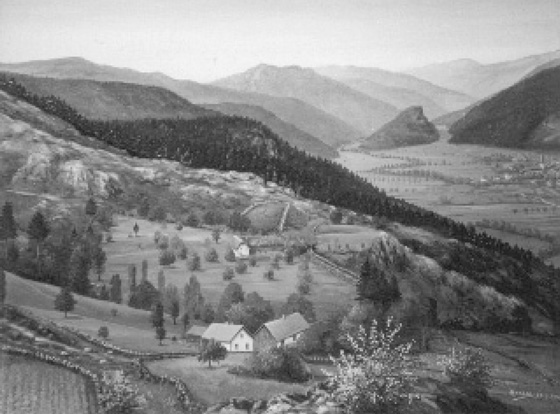
Oil painting of Bergenbach by Adolphe Arnold
In the 1890s, my grandmother Marie had left the ancestral home only to return widowed with two girls—Emma and Eugenie, my mother and my aunt. Remy Staffelbach, my grandmother Marie’s second husband, fathered my Aunt Valentine and Uncle Germain. Remy was a true grandpa to me.
Grandma was a very industrious woman who took care of all of the animals and the garden while the men went off to their jobs.
Grandpa was a color mixer in the printing factory, and Uncle Germain hewed stone in a quarry. Grandma always fretted about Uncle Germain. Because he was deaf, she worried that Uncle Germain might not get the message that the rock was about to be dynamited. Whenever she heard a blast from the quarry, no matter where she was or what she was doing, she would stop and say a prayer for her son.
With tears in her eyes, Grandma would tell me the same story over and over again: “Your mother wanted to become a nun, a missionary in Africa. We went to the convent to see about it, but the required donation was just too high. We would have had to sell all our cows.” I wondered to myself why it was necessary to sell cows to serve God.
“The family decided that she should work and use some of her earnings to pay for Germain’s boarding school. That’s how she became a weaver of damask and met your father, Adolphe. He was a penniless orphan and an artist—not a farmer—but at least he was a strong Catholic.”
Uncle Germain and I communicated easily. I enjoyed his lively homemade sign language.
Uncle Germain also did carpentry work, stone carving, and tree grafting. He had ten beehives. Each time we came for a visit, he showed us his latest achievement with a broad, happy grin. His joy in life was to be productive. Germain was very attached to his mother and, because of her, he was very religious. So was I.
When she was young, Grandma must have been beautiful. Her attractive features had hardly diminished with age. Her deep blue eyes paled next to her sunburned complexion. A small chignon of white hair on top of her head looked like a halo. During the week, Grandma wore a stern black dress covered by a big apron. But on Sundays, she wore a flowered dress with tiny pink or lilac flowers that softened her serious face.
Grandma was a little heavy, yet always quietly on the move. As soon as I came into the kitchen, she would launch into lively talk. “Let’s get the soup done for the little hog—with some potatoes.” She would mash them in her hand. “We will get some bran, our leftovers from the noon dishes, no bones, and the whey from the cheese...come, Little Girl, we’ll pour it into the manger...” The hog’s pink nose went in the soup...ch-ch-ch. “Look how foolish—it searches for the best pieces first!”
All of the chickens would gather in front of the kitchen door. “It must be five o’clock. We’ll give them some corn.”
“Back, back,” she’d say, clapping her hands and sending the vigorous ones flying onto each others’ backs. “Little Girl, see that! Just like people, no consideration for the weak.”
“Now let’s call the cats. ‘Busala busala, come...here is your milk.’” It was the foam of the milk from the cow that Grandpa had just milked. I had already had my share in a special black cup, my cup. The cats rubbed up against our legs and purred. One of them let her little one drink first. “You see, that is a true mother, and most everyone says thank you.”
Whenever possible, my parents and I would go to Bergenbach on weekends. I got to attend the great Mass with Grandpa, which was such a treat. Uncle Germain would leave the house after us, but somehow he would always beat us to church. After Mass, we three would go to the café where all of the men of the village gathered. They often talked politics, either that or about farm animals: “I bought a cow from the horse dealer.” “Which one? The Jew or the Alsatian?” “From the Jew, and he cheated me again!” “Why don’t you go to the Alsatian?” “Well, he’s too expensive. He always inflates the quality and price of his animals. He is dishonest!” I couldn’t follow their reasoning. Why did they hate Jews and yet prefer to buy from them? It didn’t make any sense.
Climbing the mountain back up to Bergenbach, at high noon in the summertime was, as Grandma said, penance that added more value to our church attendance. She must have been right, but in the summer I wished it weren’t quite so hot!
Grandpa’s face was almost as red as his hair. He wore a dark brown velvet suit with a golden chain for the watch he kept tucked in his vest pocket. He would undo all of the buttons and with his handkerchief, constantly wiped off his neck. Uncle Germain always headed home ahead of us, running off like a gazelle; then he would hide and wait for us. As we passed by, he would jump out at us with his special “horse laugh!”
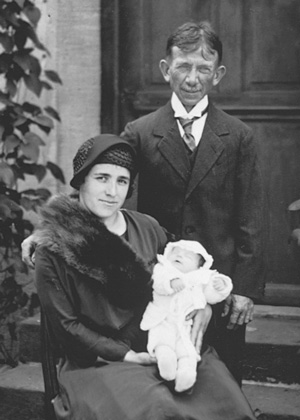
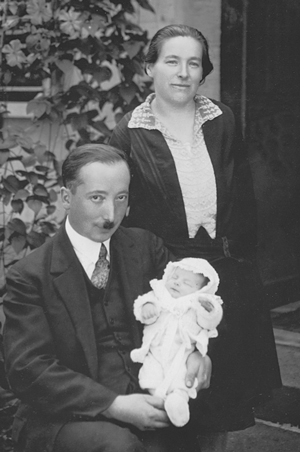
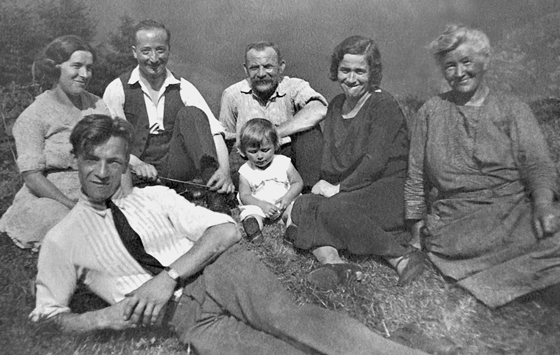
(from rear left) Mother, Father, Grandpa Remy, Aunt Eugenie, Grandma Marie, and Uncle Germain; Simone in center
Grandma attended the early Mass so she could be home in time to cook our delicious Sunday meals that included special homemade pastries of all kinds. At the meals, the chats were always interesting and lively, but always peaceful, as long as we were six at the table. How different when Grandma’s youngest daughter, my Aunt Valentine, came with her husband, Alfred, and my cousin Angele. Alfred, a tall man, always took over—he knew it all! While Alfred talked and talked, my father sat there silent. I didn’t like that. My father was smarter—why didn’t he speak up?
Drawing battle lines seemed to be Uncle Alfred’s regular goal, and it wasn’t hard to accomplish. Grandpa disliked the harsh German authority. He had served in the German maritime service for four years and had seen with his own eyes how a rebellious sailor was punished: A rope was tied around his waist, and then he was thrown into the sea and dragged behind the ship for hours. I thought that those sailors must have been very fast swimmers to be able to keep up with the ship!
Grandma always picked on the French, calling them lazy. She hadn’t forgotten that during the Great War, the French army had fed on her cows and never compensated her for them. But she had nothing but glowing praise for Hitler’s achievements in Germany.
When the verbal wars ended, usually Grandpa seemed to shrink, while Grandma seemed to grow taller. Her hands would stiffen as she angrily snatched up the dessert dishes from the table. The lacy antique dishes were beautiful and delicate, and I was always afraid that in her anger she would break them to bits.



